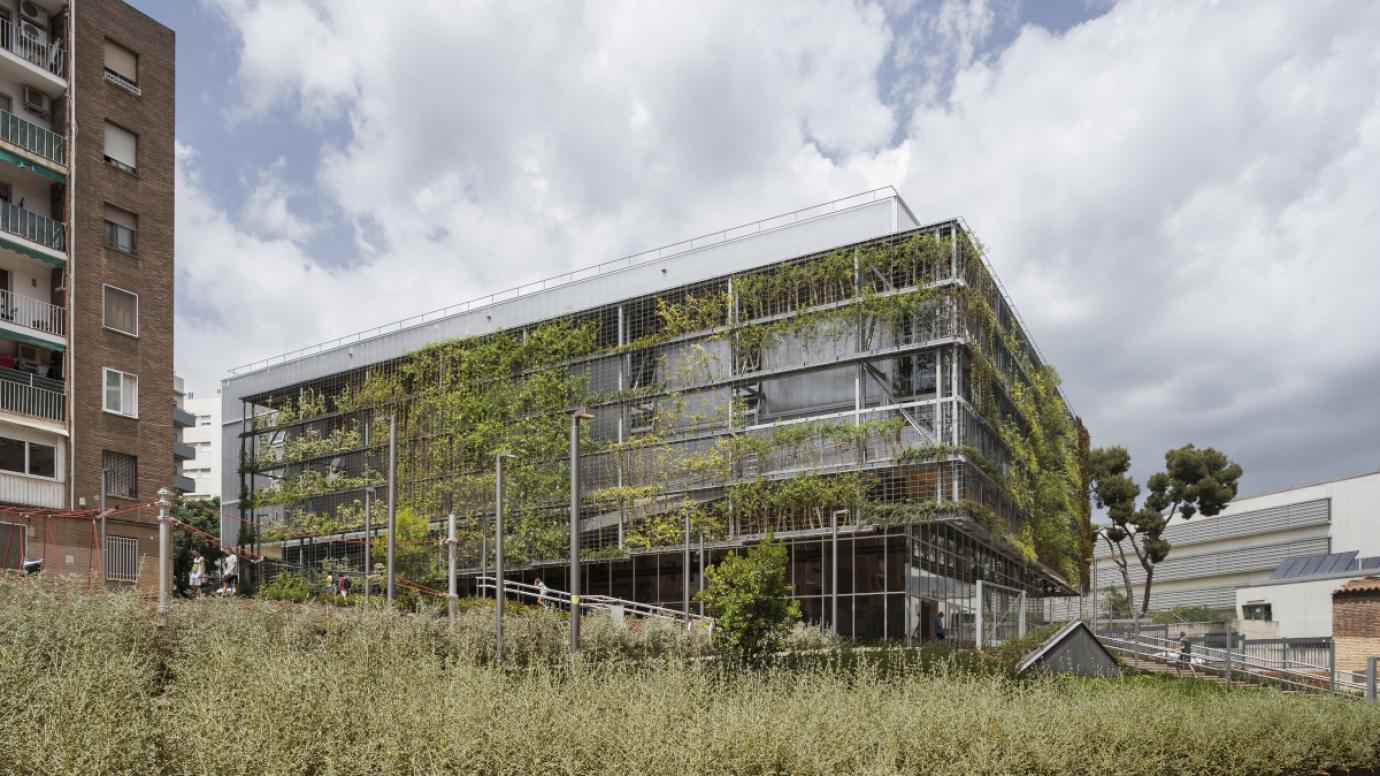Barcelona: Turó de la Peira's sports centre
Getting fit in a carbon neutral haven.
- Pays:
-
 Spain
Spain
- Type of project :
- Health and well-being
- Sustainability
- Size of city/region:
- Above 1 million inhabitants

Key facts
Architecture studios: Arquitectura Anna Noguera, J2J architects
Main sponsor: BIMSA - Institut Barcelona Esports (IBE) - Ajuntament de Barcelona
Year completed: 2018
Materials: Prefabricated laminated wood
Total area: 5 489 m²
Prizes:
- City of Barcelona Award 2019
- Sustainable Construction Grand Prize of the Green Solutions Awards 2020-21
- Sports Buildings WAF 2019 Awards
- Mapei Award for Sustainable Architecture 2019
- Shortlisted for the EUmies Award 2022
City / regional background
Turó de la Peira is an urban quarter located in a high-density, low-cost social housing neighbourhood from the 1960s in the periphery of Barcelona. The area lacked meeting places and had a shortage of green and public spaces and facilities.
An existing but outdated sports court and pool were located in the area, nestled between neighbouring buildings. The pool had suffered damage, and the outdoor sports court was inadequately sized for competitions and created noise disturbances for nearby residents. In addition, the urban landscape was characterised by hard pavement, concrete walls, and a total absence of vegetation.
An intervention was needed to turn the grey and uninhabitable environment into a green, welcoming and friendly place. Barcelona City Council decided to hold an architectural competition to upgrade the sports facilities.
Solution
The projects involved a holistic transformation of the site and its surroundings through renaturalisation and environmental regeneration.
The old sports court and pool were merged into a single building to create more free space and a garden. The new sports centre consists of two overlapping large spaces: a heated swimming pool on the semi-basement floor and a sports court on the upper floor.
The innovative building was designed to operate with minimal energy consumption, including features such as thermal insulation considering solar orientation; sensor-monitored skylights and windows for efficient cross-ventilation; a compact, partially submerged structure to minimise heat loss; and an aero-thermal system that recovers heat from hot water production. Photovoltaic panels on the roof generate up to 90% of the building's energy needs. An exterior plant facade envelops the structure, shielding it from the sun and forming a bioclimatic space. The green gallery is a hydroponic plantation system, chosen for its lightness, substrate durability, water retention capability and ease of installation.
Walls and solid surfaces were replaced with landscaped slopes that make various paths and provide sitting places and children's playgrounds.
The entire structure, pillars, girds, slabs and walls were prefabricated in the workshop and assembled on site.
Criteria for high-quality (context, sense of place, diversity, beauty)
-
The project emphasises the perceptions and feelings conveyed to those using the space. Natural light, greenery, and the incorporation of wood create a cosy ambiance, distinct from the coldness often found in comparable facilities.
-
Mindful of the topography, the building is half-buried, bridging the difference in level between the two streets.
-
The city council organised three project presentations for the inhabitants’ approval. Community members had the opportunity to articulate their concerns, aspirations, and demands, which impacted positively the project.
-
The passive architecture criteria construction has achieved an energy efficient building. The investment will be recovered in a few years by saving on energy costs. The equipment has obtained the LEED (Leadership in Energy and Environmental Design) platinum qualification.
-
The project aligns with the Barcelona City Council's commitment to people with functional diversity by ensuring access to external and internal facilities.
Governance and management
The project was executed by personnel from the Barcelona Sports Institute including staff from the administrative, legal, and sports promotion departments. The dedicated team from the Department of Facilities Projects and Works Management played a pivotal role in its successful implementation.
After defining the project, its execution was delegated to the Barcelona Municipal Infrastructures (BIMSA) company, specifically established for government-promoted construction projects.
The facility is run by the private company IGE BCN S.L, through a 4-year concession contract with the Barcelona City Council. The company is responsible for the maintenance of the installations, and for offering sport activities for various groups.
Budget and financing
The budget of the project was estimated €9 483 253 for the cost of the building and €322 289 for the cost of the park. The funding was exclusively provided by the Municipality of Barcelona.
The City Council temporarily covered for the energy expenses during the first year of operation (€110 000).
First establishment expenses to be paid by the concessionaire (€60 000 first year).
Transferable ideas
-
Develop a global vision of the project. Pay attention to the different systems that make it up concerning electrical and thermal energy consumption from the start.
-
Keep in mind from the drafting stage, the necessary maintenance of the building when it will be in operation.
-
Have a technical maintenance team trained in the new technologies applied to the building that is able to understand and manage the installations.
Contact information
Contact the Institut Barcelona Esports via email.


